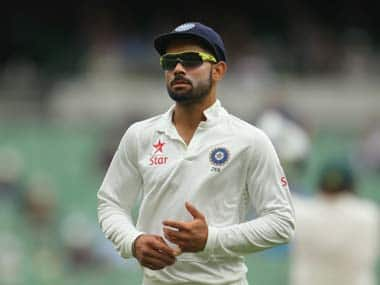2-0 - The scoreline makes an Indian fan feel better; certainly better than the last time India toured Australia where they were whitewashed 4-0. And unlike last time, there are some real positives. At least India competed this time around and it wasn’t a meek surrender of past series’, but can we honestly keep saying that these results are because India are a side in transition? It is this same young side that has got into winning positions against the likes of South Africa, New Zealand, England and now Australia but then squandered the advantage. The fact of the matter is, India haven’t learnt from their mistakes. They got into a position of authority in the first three Tests against Australia but switched off at key moments. And it took them just three sessions to lose the series. In the first Test in Adelaide, India lagged behind for most of the match but on the final day, they decided to do the unthinkable - go for victory, chase down 364. They stuttered at the start, losing Shikhar Dhawan and Cheteshwar Pujara inside 20 overs. However, Murali Vijay and Virat Kohli led India’s revival and for the first time in the Test, India had the edge as they went into tea at 205/2 with Vijay (85) and Kohli (83) looking solid. They were clearly the favourites needing 159 from 37 overs with eight wickets in hand. [caption id=“attachment_2040239” align=“alignleft” width=“380”]  Virat Kohli had an outstanding series for India. Getty Images[/caption] Kohli and his team were on the path to making history, but then, disaster struck as Vijay got nervous on 99 and was trapped LBW by Lyon with the score on 242. This sparked the famous Indian collapse as they lost their next eight wickets for 73 runs in 18 overs and were bowled out for 315. 1-0 to Australia. The story continued at Brisbane in the second Test. India made a competitive 408 in the first innings. Australia fought hard and were 221/4 at stumps on day two. The Indian bowlers started off day three on a promising note and in the first hour, making early inroads removing Shaun Marsh and Brad Haddin with just 39 runs added to the total. There were no half trackers, no short stuff, no boundary balls - it was proper disciplined bowling. After the first hour, India suffered a brain freeze. Rohit Sharma decided to rile up Mitchell Johnson and the Indian bowlers went hard on short stuff. Johnson plays short pitched bowling well, and he has a tendency to get out to full deliveries. It seemed as if the Indians hadn’t done their homework. They resorted to short stuff and got hammered as the next 57 minutes saw 91 runs scored from 12 overs conceding a staggering 14 boundaries. 131 runs were scored in that session from 23 overs for the loss of two wickets. Steven Smith registered his century and Johnson scored a brisk fifty. The last four added 258 in 48.3 overs while the top six scored 247 in 61.1 overs. The visitors never recovered from that hammering and Australia took a crucial 97-run lead in the first innings. A fired up Johnson wreaked havoc with the ball in the first session of the fourth day as India capitulated inside four days. The first session of day three made it 2-0 Australia. After the second Test, Matthew Hayden said, “India’s biggest weakness is they don’t believe they can win away from home. Whether it’s starting the day badly or not finishing an innings like they should – they seem to go missing at key moments.” Smith added to that, saying, “It’s always tough playing against India, they’ve played some extremely good cricket and we just won the key moments.” The chance of winning the series was gone but the hosts still had a chance to save it. But the lessons weren’t learnt. India had their best bowling performance on the first day of the third Test in Melbourne. They reduced the hosts to 259/5 at stumps. The in-form Smith was not out on 72 while Brad Haddin was on 23. This was the perfect chance for India to gain the advantage in the first innings. Prior to his match, the horribly out-of-form Haddin had scored 195 runs from eight Tests at an average of 15 in 2014. It was a perfect opportunity for the Indians to cash in. Again, it was the same old story, the short stuff started right from the very start of the day. The Indians had bounced out Haddin twice in the second Test but here the Australian keeper went on the counter attack. Earlier, the short ball strategy had worked in England at Lord’s. It might works once, it might even work twice, but not every time. You have to know where to draw the line. India were happy to give singles to Smith and wait for Haddin to make the mistake rather than achieving his wicket. The full ball which had helped them scalp five wickets on day one had gone missing, and within two hour India got Haddin back in form and lost the Test as they leaked 130 runs from 25 overs. From 259/5, Australia went on to pile on a mammoth 530. Having put up a massive total, Australia had made sure a loss was unlikely and the series was in the bag. India put up a fight but it was too little too late, it wasn’t enough and Smith played for safety to clinch the series with a draw. A series blown away in three sessions. Earlier, on the South Africa tour, India had set the hosts a daunting target of 458 runs at New Wanderers Stadium. The hosts were 138/2 at stumps on day four. The visitors needed eight wickets and most would have bet on an Indian victory. They let the advantage slip and nearly lost the match before South Africa played for safety and called off the chase with eight runs needed and three wickets in hand. “There were a couple of sessions where we played badly and that had an impact on both the Test matches,” now retired skipper MS Dhoni said after the series loss against South Africa. “If you have an upper hand, [you must] make sure you capitalise on that. On certain occasions, I felt that we were not able to capitalise on the upper hand. So these are a few areas we need to work on and keep improving.” Nothing changed in the next series, away to New Zealand. After losing the first Test narrowly in Auckland, India had a chance of their lifetime to save the series in Wellington. Having taken a massive lead of 246 in the first innings, they had the hosts reduced to 94/5 in the second innings and an innings defeat looked imminent for the hosts. But in a dramatic turn of events, India lost it all as Brendon McCullum (302) and co. helped New Zealand pile on 680 to set a target of 435. India had to fight for a draw. Another series lost. Same was the case in the first Test against England in Nottingham as they had the hosts on the back foot reducing them to 298/9 having posted 457 in the first innings. They squandered the advantage and gave away crucial first innings lead. India, again, had to fight for a draw. The same story keeps on repeating. Yes India has been competitive but being competitive doesn’t win you matches. It’s the final output that matters. Champion teams never give the opposition a sniff. They weaken the competitor and then deliver the knock-out punch. India needs to learn this process of delivering the lethal knockout punch!
India got into a position of authority in the first three Tests against Australia but switched off at key moments. And it took them just three sessions to lose the series.
Advertisement
End of Article


)

)
)
)
)
)
)
)
)



